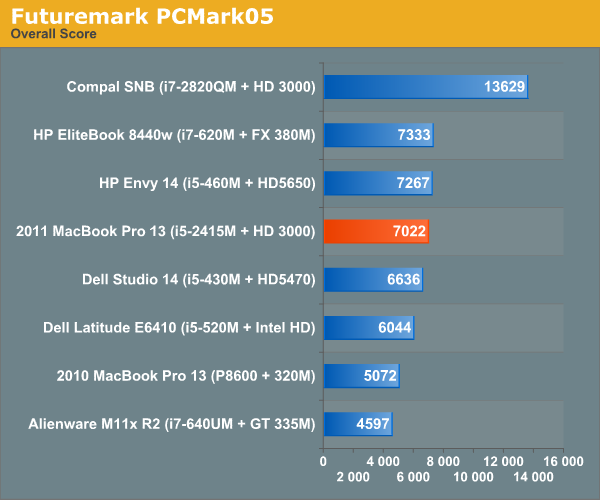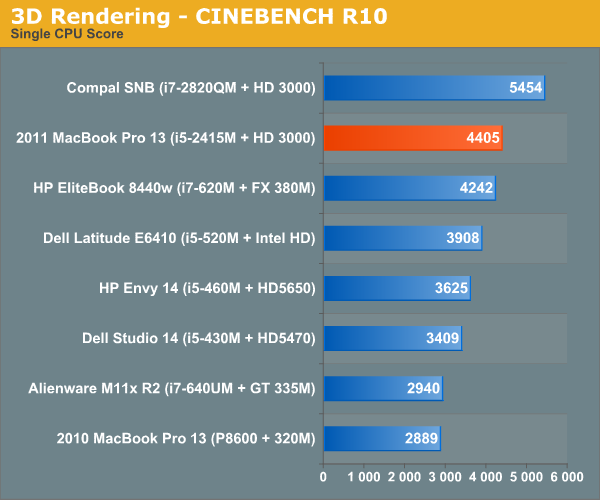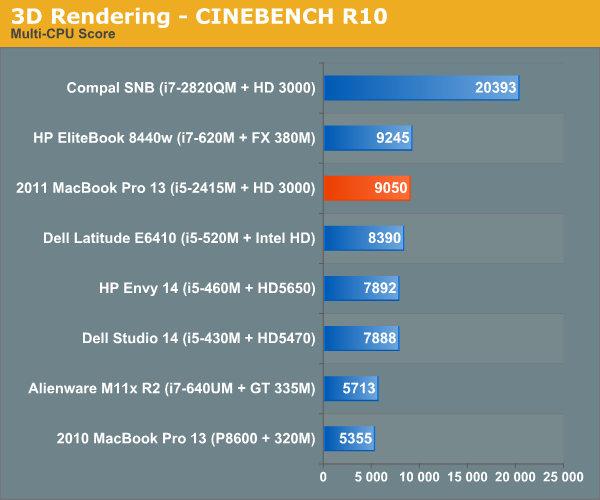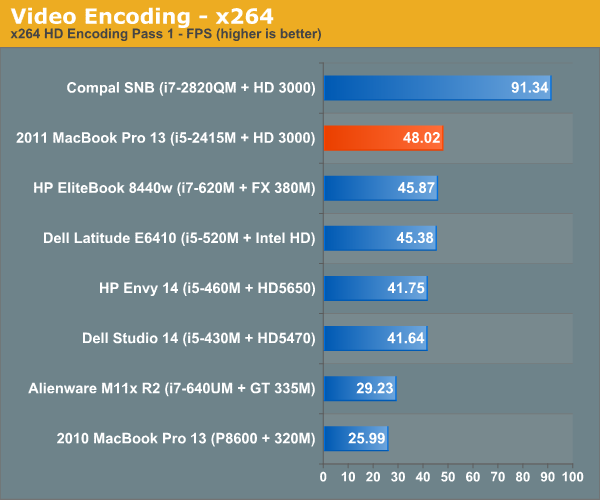The MacBook Pro Review (13 & 15-inch): 2011 Brings Sandy Bridge
by Anand Lal Shimpi, Brian Klug & Vivek Gowri on March 10, 2011 4:17 PM EST- Posted in
- Laptops
- Mac
- Apple
- Intel
- MacBook Pro
- Sandy Bridge
Application Performance in Windows
by Vivek Gowri
In keeping with recent tradition, I'm in charge of evaluating the new MBP under our Windows notebook benchmark suite. Mostly, the MBP works very well as a PC, something I looked at last year with the old 13-inch MacBook Pro. I have the new base 13 in the labs, and I must say, the overall experience is pretty similar...unless you're gaming. But I'll get to that in a minute.
Unlike on the Air I was testing last time around, the Windows install went pretty smoothly thanks to the built-in optical drive. Unfortunately, that's probably going to be the last time I ever use it. And also unlike the Air, there's no problems with storage space here—with the 320GB drive included in the base 13, you have more than enough space for two moderately-sized OS install partitions.
With Windows and Boot Camp drivers out of the way, I fired up our notebook benchmark suite. The new MBP is the first dual core Sandy Bridge notebook we've had in our labs, so I was pretty interested in seeing the performance relative to Arrandale, as well as the old Core 2 Duo-based MBP13. According to CPU-Z, the base spec 13 that I have has the i5-2415M inside, a dual core processor with HyperThreading and clocked at 2.3GHz with max turbo frequency of 2.9GHz. The 2415M is an interesting chip, closely related to the i5-2410M. It's so interesting that Intel doesn't even have a product page for it, which made me curious as to what the difference between the two is. Turns out, the 2415M is the same chip as the 2410M, just in a smaller package. The normal mobile Core i5/i7 processors have a 37.5 x 37.5mm PPGA (plastic pin grid array) package, meant for Socket G2 (also known as rPGA 988B).
The 2415M, on the other hand, has a package size of 31 x 24mm with a micro-FCBGA mounting method. It's the same package size and mounting as the low voltage and ultra-low voltage Sandy Bridge processors, using the same BGA 1023 socket. Apple probably chose the 2415M to make packaging around the processor easier. Smaller is always better in the Apple world.
The other interesting wrinkle here is that Apple has forgone a separate graphics chip for the first time in a very long while. This is the first Apple with Intel graphics since the MacBook's January 2009 refresh brought Nvidia 9400M graphics, and the first MacBook Pro with Intel graphics. Ever.
What does all of this mean for performance? Let's take a look. If you're comparing to the old Core 2 Duo based MBP13, CPU-based performance is almost two times faster across the board. Given the huge jump in power between Core 2 and the further two generations of Core processors, this makes a lot of sense. It was seriously about time that Apple moved on from Core 2 in its smaller notebooks, and this huge performance jump is a direct result. We'll see what happens with the regular MacBook and MacBook Air, but I'd expect a similarly large increase in performance in those models when they're next updated as well.






Looking at the Arrandale-based Core i5-430M, which at 2.26GHz is a logical point of comparison to the i5-2415, we see that performance has improved 15-20%.
This doesn't look as impressive as the gains in performance we saw with our first look at the mobile SNB quad-cores, but Sandy Bridge quads are clocked a lot higher than the preceding Clarksfield chips. Our quad-core SNB mobile testbed had an i7-2820QM, with a 2.3GHz core clock and max turbo frequency of 3.4GHz. The 2820QM replaces the 1.86GHz i7-840QM, so the clock speed is 24% higher. Factor that in, and the increase is more in line with what we saw from the dual-cores.
The big deal here is that now, the lowest end SNB i5 performs roughly on par with the top end Arrandale i7 dual cores. Like Anand said in his Sandy Bridge review, you get yesterday's top of the line performance for a much lower price.










198 Comments
View All Comments
iwod - Friday, March 11, 2011 - link
iPad is only just starting to sell and iPhone still has lots of space to grow. The trend is Apple are making more units and more money from ARM specific products.Nvidia has just recently stated that Project Denver will be ARM 64 bit. And aiming at HPC and Desktop. Full Compatible with current ARM instruction set.
Currently Apple must have a ARM version of Lion testing, and few years down the road, they could switch their Mac over to ARM 64 bit. Using a single Instructions Set for their whole product line.
For some reason i have been thinking that Apple and Intel aren't doing too well together like anand has felt. I dont think Thunderbolt is any indication of their current relationship. it is merely they have been working on it for such a long time, no one wants to lose our at the end.
Of coz it could have been the other way round x86 moving into iPhone, although that depends how much intel is willing to bend towards apple.
jbh129 - Friday, March 11, 2011 - link
Anand,Can you guys run your high-end 15 through the Windoze tests that were used on the 13?
Thanks
tajmahal42 - Friday, March 11, 2011 - link
Hello guys!First, I have to say this review is really awesome, as usual! Just what I was hoping for. The thoroughness and practical sense of your reviews continues to amaze me every single time.
For the 13" MBP, you mention "bouts of instability". Can you elaborate on that? Stuttering? Crashes? In what way do you notice that instability? I'm a little concerned now.
tno - Friday, March 11, 2011 - link
+1alent1234 - Friday, March 11, 2011 - link
my wife has been bugging me about our wifi since we moved and get a poor signal in a lot of the new apartment. told her i can get a new router with 3 antennas but we will also need a new laptop as well with the antennas to take advantage of it.which brings me to my question. i know the 15" model has the 3 antennas. does the 13" do MIMO as well?
tipoo - Friday, March 11, 2011 - link
They all use the new card.By the way, have you tried switching wifi channels, or installing DD-WRT and boosting signal? Even so, you don't need a new laptop after getting a new router if signal strength was the only problem.
alent1234 - Friday, March 11, 2011 - link
i'll try that, thxa lot of wifi around me these days. we only have work laptops now so that would be our only personal computer if we bought one. i was looking for the cheap SB models when they come out
name99 - Friday, March 11, 2011 - link
"told her i can get a new router with 3 antennas but we will also need a new laptop as well with the antennas to take advantage of it."This is not completely true. A base station with multiple antennas CAN do the equivalent of phase-array beam steering to direct most of the output power towards the target laptop. The laptop will thus see a stronger signal, and one of the better modulation schemes (eg 64-QAM 5/6) can be used rather than one of the weaker schemes. Thus your laptop, even if it has only one (or two) antennas can still see better performance.
Note, this is a theoretical possibility. I do not know the current state of the art in how well base stations utilize the various forms of transmit diversity that are available. And no review ever seems to talk about this stuff, either by testing how well the kit works with a single antenna device, or by talking to the manufacturer about what's in their product.
Brian Klug - Friday, March 11, 2011 - link
The 13" does have 3x3 MIMO as well, the exact same broadcom solution as the 15" I tested extensively.-Brian
7Enigma - Friday, March 11, 2011 - link
Anand and crew,I am very disappointed with the battery life numbers in this review. This is the first review of a laptop where it appears you have used a 3rd party app (Cody Krieger's gfxCardStatus tool) to significantly inflate the numbers of the new 2011 systems. 35-60% by your own numbers back on the discrete GPU battery life page, which you then fail to report in the battery life tables later on!
When you are tasked to review a system (especially an Apple product I might add) it should be reviewed as is, with no tweaking or 3rd party add-ons to boost performance/benchmarks. When have you EVER installed an add-on for a Windows-based laptop to improve performance/life? I can't think of one.
At best this was a simple oversight where you have benchmark numbers WITHOUT the gfxcardstatus, at worst this was a cover-up job which I have always argued in the forums against and on your site's behalf.
Please update the tables to show what a stock newly-purchased laptop at the Mac Store would deliver.
I am very disappointed in this coverage.